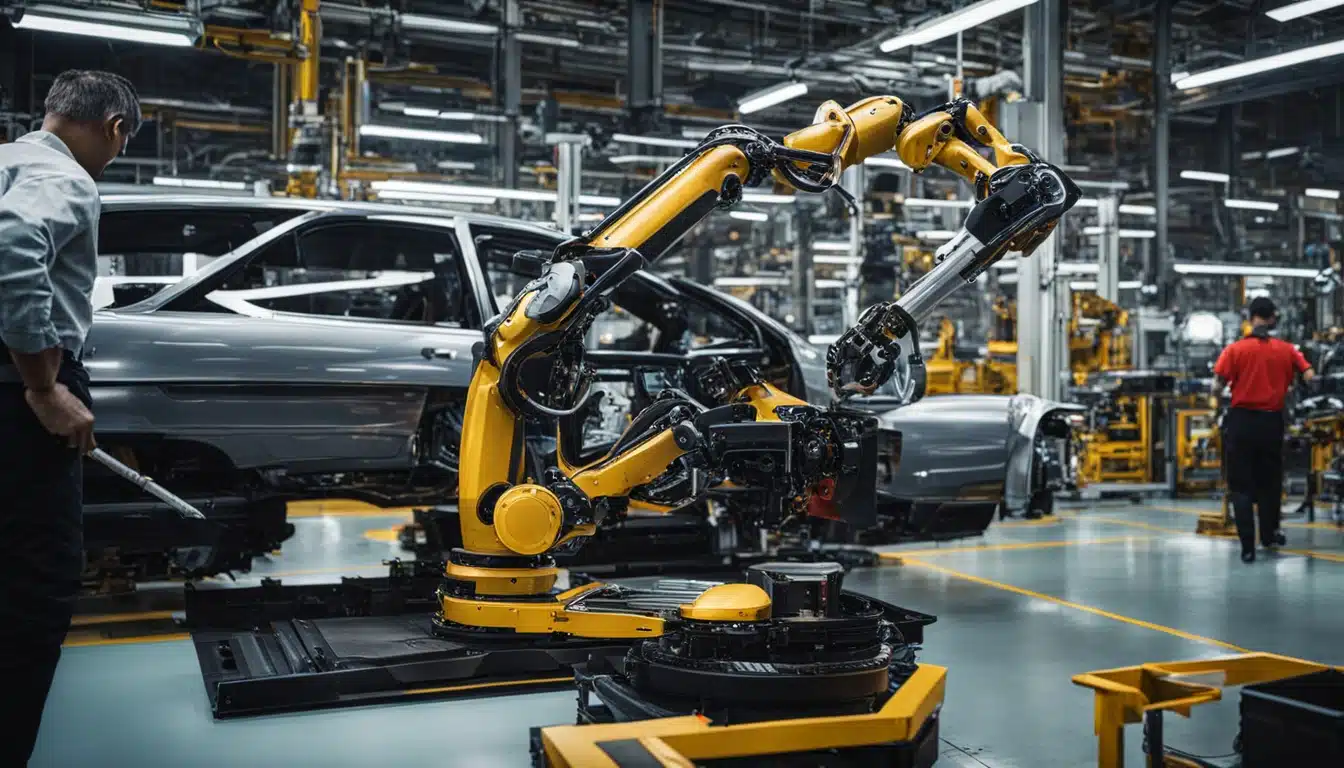Robotics in various industries by streamlining processes, enhancing efficiency, and expanding capabilities. Robotics plays a vital role in Industrial Automation. It helps keep balance in factories and shops. This balance, thanks to robotics and automation, leads to much better work. Robots are key to making things in many industries. They are great for working accurately and tirelessly, without getting tired.
In the beginning, Industrial Robotic Projects confused and surprised people. Now, automation is in many fields, including healthcare and farming. At first, electric machines started doing simple tasks again and again, without rest. The automotive industry first used these machines. Later on, industrial robots came. They not only did tasks but also learned to do better. Now, robots have changed fields like healthcare, automotive, and more.
Key Takeaways
- Robotics is a crucial component of Industrial Automation, transforming work processes and increasing efficiency.
- Robots are essential in many industries’ manufacturing processes due to their accuracy and ability to work tirelessly.
- Automation and robotics have evolved from simple repetitive tasks to more advanced, data-driven applications.
- Robots have revolutionized various industries, including healthcare, automotive, food, semiconductor, and electronics manufacturing.
- The integration of robotics and automation is shaping the future of various industries in this advanced era.
Introduction to Robotics in Manufacturing
Robots have been part of manufacturing since the early 1960s. The first one, called Unimate, started its work at a General Motors plant in 1961. It was huge, weighing over two tons, with a 6-foot arm. The Unimate worked on things like die-casting and spot welding car parts. It opened up new possibilities for making things.
Historical Overview of Robots in Manufacturing
In the 1970s, technology made robots smarter. The PUMA robot, for instance, could do more than just pick things up and place them. It was a big step forward in what industrial robots could do.
The Rise of Industrial Robots
The 1980s were a big time for industrial robots. They got better controls and programming languages. Then, in the 1990s, they could see and feel with sensors. This made them even more useful.
Impact of Robotics on Manufacturing Processes
Now, the 21st century is taking robotics to new levels, thanks to AI and machine learning. Robots can now figure things out on their own. They’re making manufacturing more productive, efficient, and flexible than ever before.
Robotics In Various Industries

For years, the automotive industry has led in the use of robotics. Since then, many industries have found advantages in robotic automation. Many tasks can fall under the “Three D’s” rule – Dirty, Dull, or Dangerous. These are perfect for robots.
Recent tech progress in machine vision and artificial intelligence boosts robots‘ performance. Now, they handle complex jobs needing recognition, judgement, and dexterity.
Industrial robots fit in where mass production happens or big items are moved. In manufacturing, they help with fabrication, finishing, transfer, and assembly. For material handling, robotics assist in picking, sorting, packaging, and palletizing. Clinical labs, agriculture, and education also benefit from them. Additionally, retail and service sectors use collaborative robots in customer-facing roles.
Industry 4.0 and the Robotic Revolution
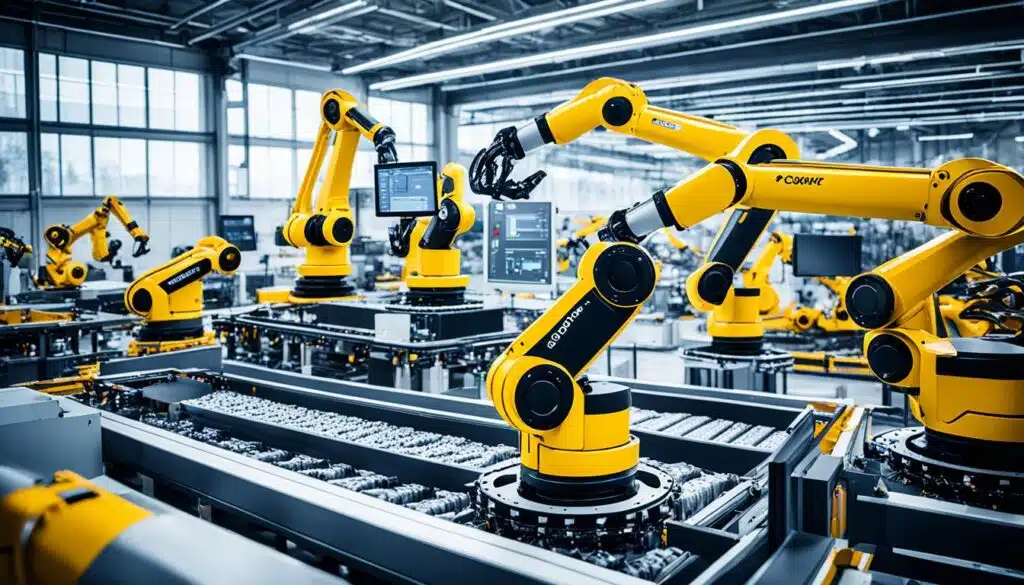
Industry 4.0 marks a big leap in how we make things. It brings together digital tech like the Internet of Things (IoT), artificial intelligence (AI), and big data. Because of this, industries run better with improved efficiency, flexibility, and productivity. Robotics is key, making automation and smart manufacturing possible.
The Concept of Smart Factories
The idea of the “smart factory” is at the heart of Industry 4.0. Here, everything talks to everything else. Robots make this possible by running complicated jobs automatically and sharing info instantly.
Integration of Robotics with AI and Machine Learning
Adding AI and machine learning boosts what manufacturing robots can do. Now they can get smarter over time, handle new jobs, and do better each time. So, these robots are not just smarter, they can also work in many kinds of industries.
Collaborative Robots (Cobots) and Human-Robot Interaction
Collaborative robots or “cobots” are a highlight in Industry 4.0. They work right alongside us human workers and make work easier and safer. Cobots handle things like precision, strength, or endurance. This teamwork between humans and robots changes how we do manufacturing, making us all better and more efficient.
Types of Manufacturing Robots
Manufacturing robots come in many forms, each with its specific focus and strengths. These robot types play a key role in the robotics to automate lots of manufacturing tasks. These include putting things together, moving materials, welding, and checking quality.
Articulated Robots
Articulated robots lead as the versatile and widely used types of industrial robots in the field. They have many joints, letting them move in lots of ways. These are great for tasks needing flexibility. The 6-axis robot is a common type, offering six ways to move. This means they are very good at doing detailed and careful work. They find their place in assembly, painting, welding, and moving things around.
Cartesian Robots
Cartesian robots move in a straight line on three axes, forming a basic grid (X, Y, Z). They are great for tasks demanding accuracy. This makes them perfect for use with CNC machines and 3D printing.
SCARA Robots
SCARA robots work quickly and precisely. They are often seen in the electronics and chip-making industries.
Delta Robots
Delta robots use a special parallel design, making them super fast. They are used a lot in places where items need to be picked up and put in a new spot. This happens in packaging and preparing food.
Applications of Robotics in Manufacturing
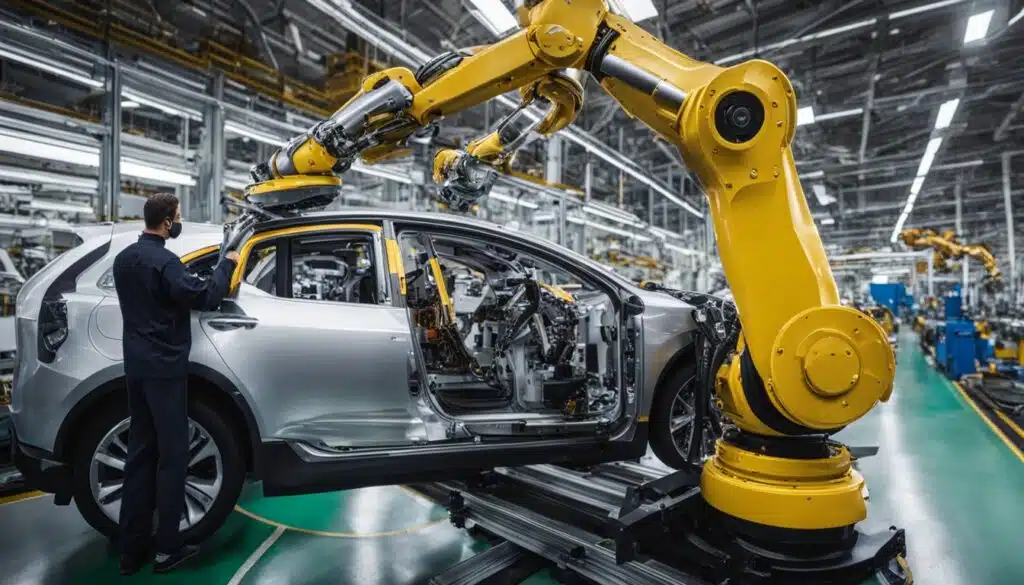
For decades, manufacturing has used robots. They do many things thanks to their unique abilities. In the welding and cutting field, robots became game changers in the 1980s. They started handling welding tasks at high temperatures. This made metal joining more precise and workers safer.
Assembly and material handling
Robots play key roles in moving and packaging items in factories. They cut down on costs and the riskiest jobs previously done by humans. Also, in machine tending, they handle putting materials into machines. This makes the whole process more efficient.
Many sectors, such as the automotive industry make use of robots for painting and finishing. This means products are similar in quality, saving money by needing less rework. Robots also work in assembling, doing repetitive tasks quickly and accurately. But it doesn’t stop there. Robots assist in other parts of manufacturing too. This includes
Robotics in Automotive Manufacturing

In the automotive world, robots are key in making cars. They are in charge of everything from welding and painting to putting cars together and checking them. This helps make sure everything is done with precision, accuracy, and speed. Welding robots have high-tech sensors to weld faster and better, making each car’s welding job perfect. They also handle materials, load machines, and keep an eye on how everything is being made. This makes the whole process run more smoothly.
The use of robots in making cars has completely changed the game. It has made the industry more productive and has increased the quality of cars. In the automotive industry, robots do a lot. They put parts together perfectly and paint cars flawlessly. This change to more automation has not just made things go faster. It has also kept workers away from dangerous or monotonous jobs.
The way cars are made is always improving. Because of this, robots are becoming even more important. Manufacturers are using new robotic systems that can do different jobs, learn, and even get better over time because of technologies like artificial intelligence and machine learning. This mix of the latest tech with robotics is making robots a must-have in the car making business.
Robotics in Electronics Manufacturing
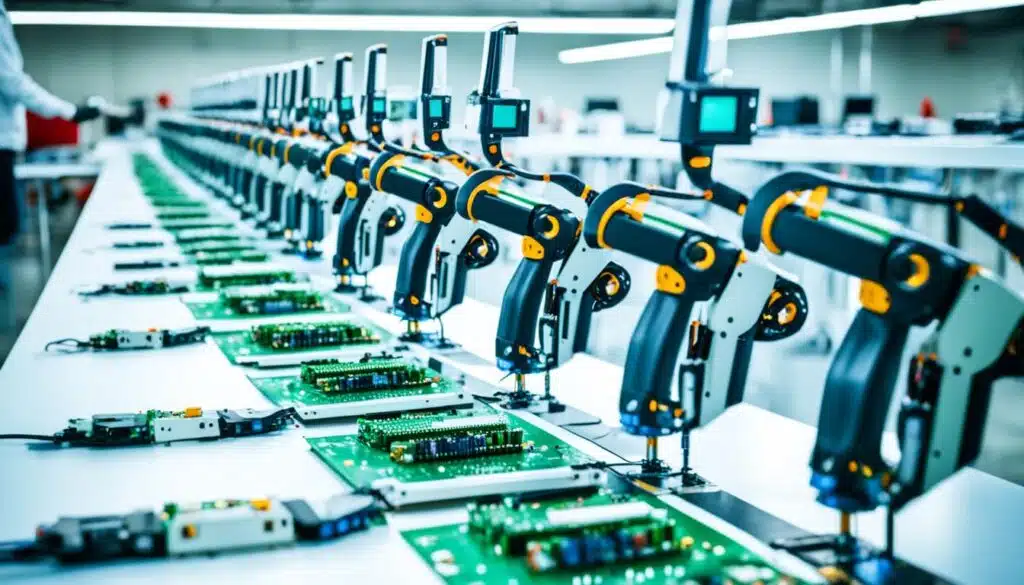
Robotics are changing electronics manufacturing, making it better. High-speed pick-and-place robots can accurately place parts on circuit boards fast and precisely. They beat people in speed and accuracy easily. Robotic soldering systems help make products better by reducing mistakes and keeping things uniform.
| Application | Benefit |
|---|---|
| Pick-and-Place Robots | Increased speed and precision in electronic component placement |
| Robotic Soldering | Improved consistency and reduced defects in electronics manufacturing |
“The integration of robotics in electronics manufacturing has revolutionized the industry, enabling us to achieve new levels of efficiency and quality in our production processes.”
– John Doe, VP of Manufacturing, ABC Electronics
Robots are key in the growing electronics industry. They boost speed, precision, and quality. This helps electronics manufacturing firms improve and beat competitors.
Robotics in Aerospace Manufacturing
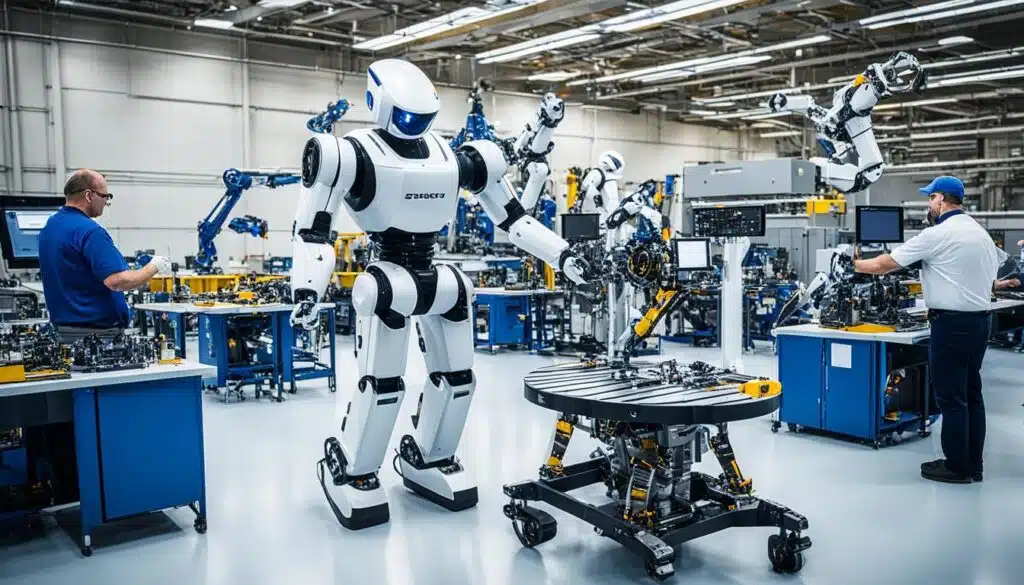
Aerospace manufacturing needs extreme accuracy and safety. This makes robotics in aerospace manufacturing vital. Machines for guided drilling put holes in exactly the right spot with ±0.001 inches variation, which is key for safety. Robotics also ensure materials like composites are the same thickness, hitting aerospace’s high standards.
The aerospace industry is using robots in aerospace manufacturing more and more. These robots drill holes perfectly and layer composites evenly. They are now crucial in making sure aerospace parts are top-notch in quality and safety.
Robotics in Metal and Plastic Manufacturing
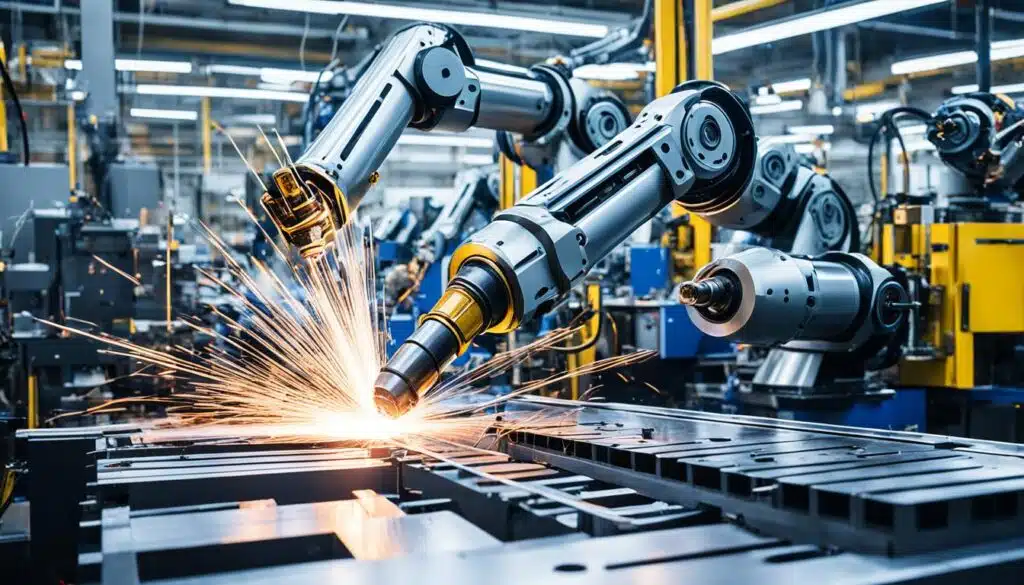
Metal and plastic manufacturing have seen big benefits from adding robots. In metalwork, robots in metal manufacturing keep quality high and make things faster in welding, cutting, and machining. Robots in plastic manufacturing also play a big role, helping in processes from injection to blow molding. This makes production more efficient, precise, and competitive.
Metal manufacturing and plastic manufacturing use robots in many ways. For example, robotic welding systems create exact, consistent welds thanks to advanced sensors. It makes metal parts better. In plastic work, robots do detailed molding work very accurately. This ensures the products are of high quality.
| Robotic Applications in Metal Manufacturing | Robotic Applications in Plastic Manufacturing |
|---|---|
|
|
Robots have changed the game for metal manufacturing and plastic manufacturing. They’ve optimized production and improved quality. They’ve also helped in staying competitive. Technology in robotics is always growing. This means the future of these sectors is hitched to the progress of robot systems.
Benefits and Challenges of Robotics in Manufacturing
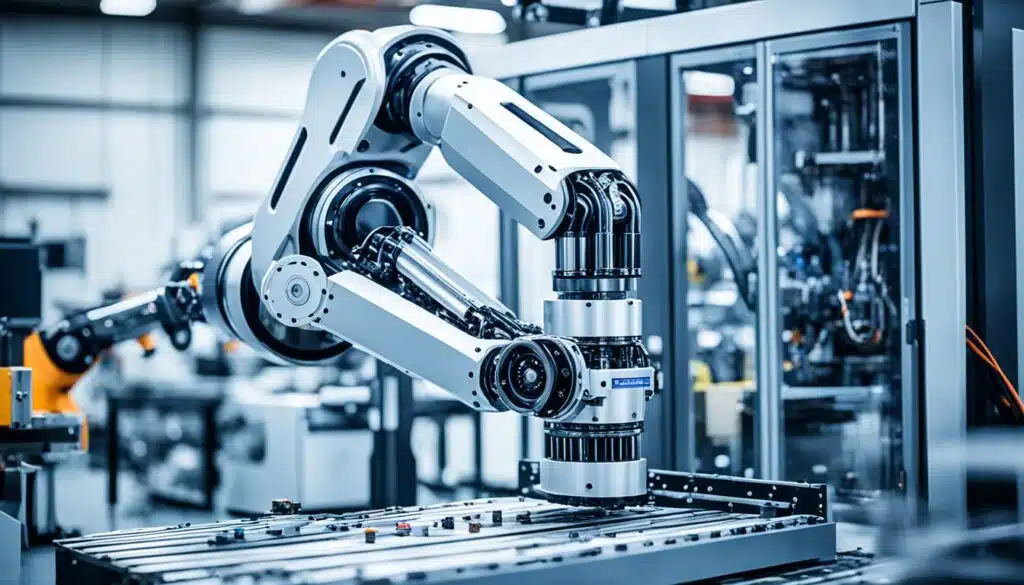
The use of robots in manufacturing has brought many benefits. It leads to increased productivity and efficiency, improved quality and consistency, and enhanced worker safety. Robots work non-stop without getting tired, producing things with great precision. This speeds up how quickly things are made, making sure products are similar in quality.
Robots also take on the risky and boring jobs. This helps keep human workers safe from harm. So, factories are safer for everyone thanks to robots.
Increased Productivity and Efficiency
Manufacturing robots work all day, every day, boosting how much gets made. They do tasks over and over perfectly and quickly. This makes everything run smoother, cuts down on waste, and uses resources better.
Improved Quality and Consistency
Robots make sure each item is just like the last one, saving us from the little differences people might make. This means fewer mistakes in what we make, making customers happier. It also helps factories compete better.
Enhanced Worker Safety
Robots handle the tough and dangerous jobs, keeping people out of harm’s way. This safety benefit not only helps workers but also saves companies money on accidents and claims.
Initial Investment and Integration Challenges
Even with all the good they do, getting robots into factories is hard and costly. Companies need the money and time to buy them and teach people to use them. Solving these issues is key to reaping all the rewards of having robots in factories.
| Benefits of Robotics in Manufacturing | Challenges of Robotics in Manufacturing |
|---|---|
| Increased Productivity and Efficiency | Initial Investment and Integration Costs |
| Improved Quality and Consistency | Need for Skilled Personnel |
| Enhanced Worker Safety | Resistance to Change |
| Reduced Waste and Downtime | Cybersecurity Concerns |
| Increased Competitiveness | Ethical Considerations |
Future of Robotics in Manufacturing
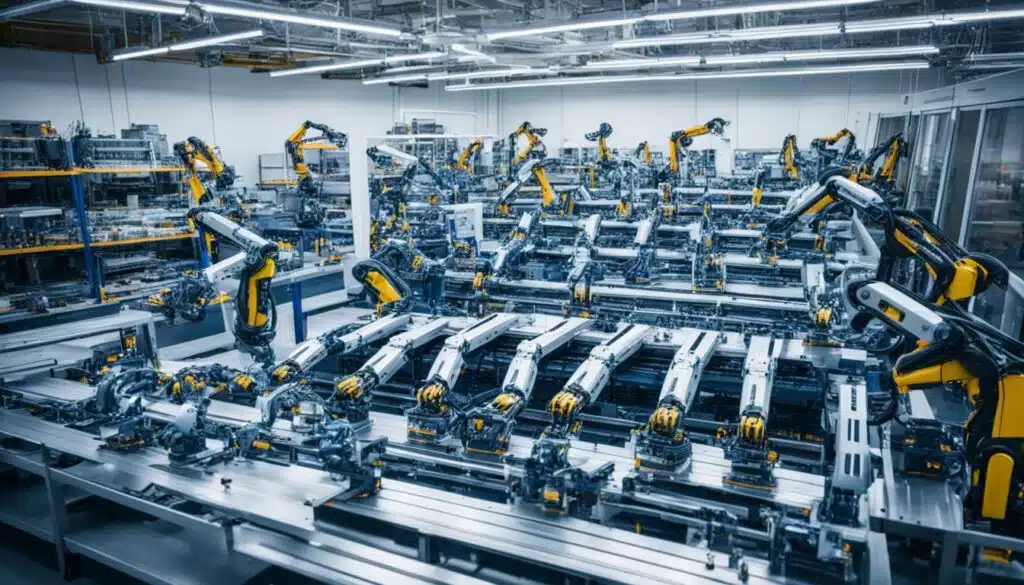
The future of robotics in manufacturing is full of promise. Artificial intelligence (AI) and machine learning are key. They will help robots do more tasks, improve how they work, and decide things on their own.
Also Read : Survey Methodology Tips For Accurate Research
Advancements in AI and Machine Learning
AI and machine learning will change how robots work in manufacturing. With these technologies, robots will get smarter over time. They’ll be able to handle new tasks and make decisions to boost how well they work. This makes manufacturing more agile and efficient.
5G and Industrial Internet of Things (IIoT)
5G technology and the Industrial Internet of Things (IIoT) will have a big impact too. 5G’s fast, stable connections will let robots, machines, and systems share data in real time. This means smoother automation and better responsiveness in manufacturing.
Robotic Process Automation (RPA)
Robotic Process Automation (RPA) will also be important. It will handle boring tasks, leaving people to focus on important work. This makes manufacturing more efficient and competitive.
With these tech advances, robotics is becoming crucial for manufacturing. Using robotics and automation smartly will help companies succeed in the future.
Conclusion
Robotics is now key in modern manufacturing, changing industries and how things are made. Beginning with industrial robots to the latest in AI and collaborative robots, robotics in manufacturing grows more vital. Through advances like Industrial Internet of Things and machine learning, robots can learn and perform better.
The manufacturing landscape is changing fast. The future of robotics in this industry looks bright. With 5G and robotic process automation, they’ll boost efficiency, productivity, and competitiveness. Companies using robotics and automation will do great in the 21st-century manufacturing landscape.
Industrial robotics and automation technology are reshaping manufacturing. They’re making AI-powered manufacturing happen, driving robotics integration in all fields.
FAQs
Q: What industries use robotics?
A: Robotics are used across industries such as manufacturing, pharmaceutical, and warehouse management.
Q: What are the benefits of robotics in manufacturing?
A: Robotics in manufacturing offer increased efficiency, precision, and consistency in production processes.
Q: How are robots used in manufacturing?
A: Robots are used in manufacturing for tasks like welding, assembly, packaging, and material handling.
Q: What types of robots are commonly used in industries?
A: Common types of robots used in industries include robotic arms, mobile robots, and autonomous mobile robots.
Q: What are some robotics applications in industrial settings?
A: Robotics applications in industrial settings range from automation of repetitive tasks to complex operations that require precision.
Q: How have robotics technologies evolved in manufacturing industries?
A: Robotics technologies have advanced to allow robots to perform a wide range of tasks, making them crucial in modern manufacturing processes.
Q: What role do warehouse robots play in logistics?
A: Warehouse robots are used to optimize warehouse operations by automating tasks like inventory management, picking, and packing.
